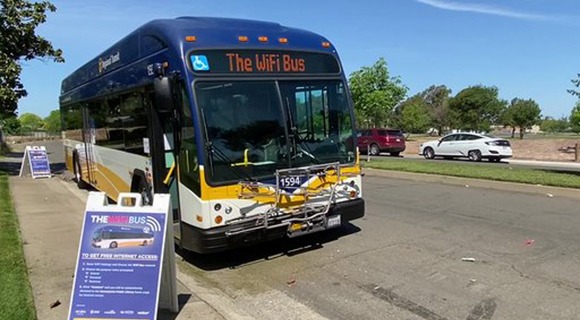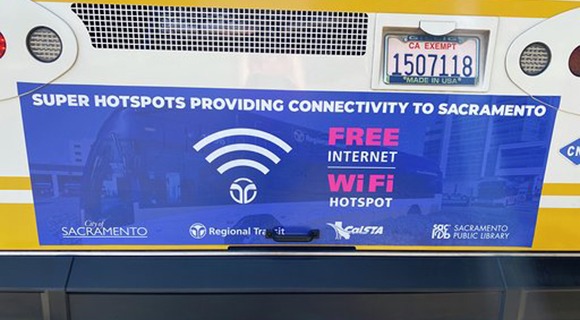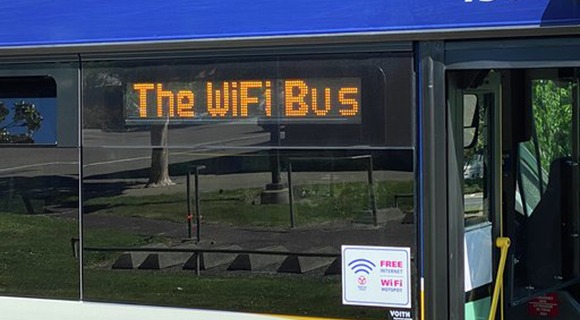

Innovative multi-agency Wi-Fi Bus proof of concept delivers connectivity to digital deserts using Aruba SD-Branch Gateways, Wi-Fi and Central
-
Customer Profile
The California State Transportation Agency (CalSTA), the City of Sacramento and the Sacramento Regional Transit District (SacRT) teamed up to turn 10 public transit buses into free wireless super-hotspots during a 60-day proof of concept that delivered daily high-speed internet access to digital desert communities across Sacramento.- Vertical: Government
- Location: Sacramento, California, United States
Use Case
Bring access to communities with limited high-speed internet access during the COVID-19 pandemic, and beyond, by turning public transit buses into free wireless super-hotspots for a proof of concept to promote opportunities for distance learning, telework and telehealth.
Requirements
- Support distance learning, telework and telehealth with high-performance Wi-Fi
- Furnish broadband outdoor connectivity with sufficient range to enable social distancing
- Utilize an automated, centrally managed SD-Branch platform for intelligent, cost-effective networking
- Engineer a solution that can be easily deployed by other state and local government agencies
Solution
Outcomes
- Delivered high-performance Wi-Fi to schools, parks and libraries, census drives, fresh food distribution sites, resource fairs and community events via mobile super-hotspots
- Provided reliable, secure connectivity to targeted neighborhoods
- Utilized an automated, smart, streamlined platform for speedy, zero-touch deployment and low network management overhead and fast report generation
- 统一technology contributed by multiple project partners to supply consistent user experiences, capture analytics and enable a guest portal
- Produced granular analytic reports for determining user needs and behaviors as well as network bandwidth requirements
With schools, workplaces, community spaces, and public transit adjusting to public health guidelines during the first wave of the COVID-19 pandemic, the California State Transportation Agency (CalSTA) began considering how it could help close the digital divide at a time when a reliable internet connection became even more essential to daily life.“In California, approximately one in five students lack high-speed internet access and nearly half of all low-income households do not have broadband service at home,” explains Lori Pepper, the Deputy Secretary of Innovative Mobility Solutions for CalSTA. “We wanted to find a practical and cost-effective way to bring high-performance Wi-Fi connectivity to digital deserts to serve our residents during these days of tele-everything.”
Agencies Team Up to Develop Innovative Mobile Super-Hotspots
CalSTA asked the City of Sacramento and the Sacramento Regional Transit District (SacRT) to partner in the creation of outdoor mobile super-hotspots using SacRT transit buses in a 60-day proof of concept (POC).
Called the Wi-Fi Bus network, the multi-agency effort was led by representatives from the Sacramento Public Library, public health departments, and the Valley Vision civic organization, as well as CalSTA, the City and SacRT. The group’s primary goal was safely enabling distance learning, supporting telework and supplying telehealth opportunities.

With the public library committed to providing Wi-Fi Bus parking at its branches and robust online resources for students to access when connected, the steering committee reached out to various cellular service providers, such as AT&T. The providers helped assemble a consortium of project partners including Aruba, a Hewlett Packard Enterprise company.
Aruba’s SD-Branch Powers Wi-Fi Bus Proof of Concept
In addition to supplying Wi-Fi connectivity, key project goals included determining the services users required, creating policy guidelines, and establishing the specific technologies necessary for successfully delivering, monitoring, and evaluating wireless access.
During the project’s design phase, Aruba and the other technology partners considered options for addressing multiple requirements for outfitting a total of 10 SacRT transit buses. This included broadcasting Wi-Fi widely enough to encourage social distancing and leveraging the available cellular network within a targeted neighborhood for connectivity.
Delivering outdoor connectivity and collecting analytics up to 1,800 feet
On three of the Wi-Fi Buses, an Aruba SD-Branch solution was engineered based on Aruba ESP (Edge Services Platform) infrastructure. It was comprised of Aruba’s 370 Series outdoor Wi-Fi access points (APs), 9000 Series Branch Gateways, and cloud-native Central for unified gateway management, which are all solutions within Aruba ESP (Edge Services Platform). In addition, LTE routers from two different partners provided the wireless uplinks to the three dominant local cellular networks.
With the design specifications calling for APs to be mounted externally, selecting the 370 Series APs ensured Aruba could deliver Wi-Fi up to 1,800 feet away from the buses. Another key AP attribute was the location awareness required for gathering the proximity analytics that were key to the initiative’s evaluation phase.
Aruba Central Proves Key to Initiative Success
Using Central to deploy and manage the Aruba ESP-equipped buses streamlined all aspects of implementation and operations. The lean project administration team worked safely from their home offices after an AT&T technician affixed the Aruba APs to the sides of each bus, plugged in the branch gateways and connected the LTE routers.
Once the gear was connected, the project administration team used Central’s Zero-Touch Provisioning capability to automate the configuration, application and management of settings. Central also created the appropriate tunnels and propagated routes to establish a flexible and secure Wi-Fi network overlay topology.
Central’s intelligence not only reduced configuring each bus to seconds, but also eliminated any further branch configuration or management intervention throughout the POC.
Troubleshooting was also a breeze with Central’s end-to-end visibility. Of the two network connectivity incidents that occurred during the initiative, Central quickly identified both as being related to LTE router malfunctions.
Granular reporting assists with evaluating outcomes and establishing ongoing needs
Central also automated weekly reporting, ensuring the team could collect statistical data with a few clicks. The granular reports included bandwidth utilization, wireless data usage, and longest connected distance from a Wi-Fi Bus. In addition, Central produced location-aware analytics, such as the number of devices in proximity to a bus and, of those, the percentage that connected to Wi-Fi.
Via Central, it was discovered that approximately 50 percent of the devices within proximity of an Aruba-enabled Wi-Fi Bus connected to the Wi-Fi and the longest connected distance was 300 yards.
Other key findings included the top applications accessed and the categories of data traffic, such as content delivery networks.
ClearPass Unifies Experiences, Boosts Security and Delivers Critical
As the remaining seven buses utilized Wi-Fi technology from other project partners, the multi-agency steering committee quickly determined the user experience was inconsistent. Access security was also insufficient and reporting across all buses was lacking.
Addressed by adding Aruba’s ClearPass, a network access control solution that is open and interoperable with other networks. ClearPass unified Wi-Fi experiences across all 10 Wi-Fi Buses, permitting the rapid and smooth implementation of a customized guest portal. It also improved security and furnished granular connection troubleshooting.

ClearPass also supplied essential device utilization data. Critical information included daily, weekly and aggregate device connections as well as the percentage of devices connecting for school, work and personal purposes.
Celebrating Success and Considering Next Steps
During the execution phases of the initiative, SacRT transit buses traveled to multiple locations throughout the Sacramento area.
Although the primary deployment focus was schools, libraries, parks, and neighborhoods within digital deserts, the Wi-Fi Bus program was also instrumental in providing much needed connectivity for regional events that provided support for job-seekers, health and wellness, and mobile Census registration.
“We’re proud of using our buses in an innovative way to help communities across the Sacramento region get the high-speed internet connection needed to address their education, telehealth and telework challenges,” said Henry Li SacRT General Manager/CEO. “We’re pleased that SacRT was able to serve those most impacted by the pandemic via the Wi-Fi Buses.”
Evaluation gives initiative two thumbs up
Following the POC, CalSTA conducted an evaluation to determine the long-term viability and potential use cases of turning vehicles into mobile hotspots and assembled recommendations for other agencies and communities to follow.
“COVID-19 put a spotlight on a critical need in our community,” says Louis Stewart, Chief Innovation Officer for the City of Sacramento. “We worked quickly with our partners to bring this Wi-Fi bus proof of concept to life to help students, workers and residents who needed broadband access. I am thrilled that we were able to provide this important tool to bring vital internet connection to our neighborhoods.”
The initiative also attracted the attention of other state and local governments across the U.S. “This reinforced the success of our program and the importance of utilizing existing assets in innovative ways. Our work must continue beyond this proof of concept,” Pepper says.
Creating a Mobile Hotspot Playbook
Given the positive reception by area residents and the POC’s overall cost-effectiveness, CalSTA is optimistic that similar initiatives could be deployed as needed going forward. To assist others, it has published a publicly availableMobile Hotspot Playbookwith detailed information and strategies.
“We’re excited to provide a document of best practices and lessons learned from our proof of concept to help other jurisdictions create their own programs to serve their communities,” Pepper says.

“Access to a high-quality, secure broadband connection is a critical piece of everyday life,” she continues. “Lack of this access by the general public has been emphasized during the COVID-19 pandemic. By using existing resources, such as transit buses, we’re able to provide mobile, temporary solutions to fill those gaps, as the state continues to work toward more permanent solutions in Governor Gavin Newsom’s Broadband for All initiative.”
We wanted to find a practical and cost-effective way to bring high-performance Wi-Fi connectivity to digital deserts to serve our residents during these days of tele-everything.
Lori Pepper, Deputy Secretary, Innovative Mobility Solutions, CalSTA -
Customer Profile
The California State Transportation Agency (CalSTA), the City of Sacramento and the Sacramento Regional Transit District (SacRT) teamed up to turn 10 public transit buses into free wireless super-hotspots during a 60-day proof of concept that delivered daily high-speed internet access to digital desert communities across Sacramento.- Vertical: Government
- Location: Sacramento, California, United States
Use Case
Bring access to communities with limited high-speed internet access during the COVID-19 pandemic, and beyond, by turning public transit buses into free wireless super-hotspots for a proof of concept to promote opportunities for distance learning, telework and telehealth.
Requirements
- Support distance learning, telework and telehealth with high-performance Wi-Fi
- Furnish broadband outdoor connectivity with sufficient range to enable social distancing
- Utilize an automated, centrally managed SD-Branch platform for intelligent, cost-effective networking
- Engineer a solution that can be easily deployed by other state and local government agencies
Solution
Outcomes
- Delivered high-performance Wi-Fi to schools, parks and libraries, census drives, fresh food distribution sites, resource fairs and community events via mobile super-hotspots
- Provided reliable, secure connectivity to targeted neighborhoods
- Utilized an automated, smart, streamlined platform for speedy, zero-touch deployment and low network management overhead and fast report generation
- 统一technology contributed by multiple project partners to supply consistent user experiences, capture analytics and enable a guest portal
- Produced granular analytic reports for determining user needs and behaviors as well as network bandwidth requirements
With schools, workplaces, community spaces, and public transit adjusting to public health guidelines during the first wave of the COVID-19 pandemic, the California State Transportation Agency (CalSTA) began considering how it could help close the digital divide at a time when a reliable internet connection became even more essential to daily life.“In California, approximately one in five students lack high-speed internet access and nearly half of all low-income households do not have broadband service at home,” explains Lori Pepper, the Deputy Secretary of Innovative Mobility Solutions for CalSTA. “We wanted to find a practical and cost-effective way to bring high-performance Wi-Fi connectivity to digital deserts to serve our residents during these days of tele-everything.”
Agencies Team Up to Develop Innovative Mobile Super-Hotspots
CalSTA asked the City of Sacramento and the Sacramento Regional Transit District (SacRT) to partner in the creation of outdoor mobile super-hotspots using SacRT transit buses in a 60-day proof of concept (POC).
Called the Wi-Fi Bus network, the multi-agency effort was led by representatives from the Sacramento Public Library, public health departments, and the Valley Vision civic organization, as well as CalSTA, the City and SacRT. The group’s primary goal was safely enabling distance learning, supporting telework and supplying telehealth opportunities.

With the public library committed to providing Wi-Fi Bus parking at its branches and robust online resources for students to access when connected, the steering committee reached out to various cellular service providers, such as AT&T. The providers helped assemble a consortium of project partners including Aruba, a Hewlett Packard Enterprise company.
Aruba’s SD-Branch Powers Wi-Fi Bus Proof of Concept
In addition to supplying Wi-Fi connectivity, key project goals included determining the services users required, creating policy guidelines, and establishing the specific technologies necessary for successfully delivering, monitoring, and evaluating wireless access.
During the project’s design phase, Aruba and the other technology partners considered options for addressing multiple requirements for outfitting a total of 10 SacRT transit buses. This included broadcasting Wi-Fi widely enough to encourage social distancing and leveraging the available cellular network within a targeted neighborhood for connectivity.
Delivering outdoor connectivity and collecting analytics up to 1,800 feet
On three of the Wi-Fi Buses, an Aruba SD-Branch solution was engineered based on Aruba ESP (Edge Services Platform) infrastructure. It was comprised of Aruba’s 370 Series outdoor Wi-Fi access points (APs), 9000 Series Branch Gateways, and cloud-native Central for unified gateway management, which are all solutions within Aruba ESP (Edge Services Platform). In addition, LTE routers from two different partners provided the wireless uplinks to the three dominant local cellular networks.
With the design specifications calling for APs to be mounted externally, selecting the 370 Series APs ensured Aruba could deliver Wi-Fi up to 1,800 feet away from the buses. Another key AP attribute was the location awareness required for gathering the proximity analytics that were key to the initiative’s evaluation phase.
Aruba Central Proves Key to Initiative Success
Using Central to deploy and manage the Aruba ESP-equipped buses streamlined all aspects of implementation and operations. The lean project administration team worked safely from their home offices after an AT&T technician affixed the Aruba APs to the sides of each bus, plugged in the branch gateways and connected the LTE routers.
Once the gear was connected, the project administration team used Central’s Zero-Touch Provisioning capability to automate the configuration, application and management of settings. Central also created the appropriate tunnels and propagated routes to establish a flexible and secure Wi-Fi network overlay topology.
Central’s intelligence not only reduced configuring each bus to seconds, but also eliminated any further branch configuration or management intervention throughout the POC.
Troubleshooting was also a breeze with Central’s end-to-end visibility. Of the two network connectivity incidents that occurred during the initiative, Central quickly identified both as being related to LTE router malfunctions.
Granular reporting assists with evaluating outcomes and establishing ongoing needs
Central also automated weekly reporting, ensuring the team could collect statistical data with a few clicks. The granular reports included bandwidth utilization, wireless data usage, and longest connected distance from a Wi-Fi Bus. In addition, Central produced location-aware analytics, such as the number of devices in proximity to a bus and, of those, the percentage that connected to Wi-Fi.
Via Central, it was discovered that approximately 50 percent of the devices within proximity of an Aruba-enabled Wi-Fi Bus connected to the Wi-Fi and the longest connected distance was 300 yards.
Other key findings included the top applications accessed and the categories of data traffic, such as content delivery networks.
ClearPass Unifies Experiences, Boosts Security and Delivers Critical
As the remaining seven buses utilized Wi-Fi technology from other project partners, the multi-agency steering committee quickly determined the user experience was inconsistent. Access security was also insufficient and reporting across all buses was lacking.
Addressed by adding Aruba’s ClearPass, a network access control solution that is open and interoperable with other networks. ClearPass unified Wi-Fi experiences across all 10 Wi-Fi Buses, permitting the rapid and smooth implementation of a customized guest portal. It also improved security and furnished granular connection troubleshooting.

ClearPass also supplied essential device utilization data. Critical information included daily, weekly and aggregate device connections as well as the percentage of devices connecting for school, work and personal purposes.
Celebrating Success and Considering Next Steps
During the execution phases of the initiative, SacRT transit buses traveled to multiple locations throughout the Sacramento area.
Although the primary deployment focus was schools, libraries, parks, and neighborhoods within digital deserts, the Wi-Fi Bus program was also instrumental in providing much needed connectivity for regional events that provided support for job-seekers, health and wellness, and mobile Census registration.
“We’re proud of using our buses in an innovative way to help communities across the Sacramento region get the high-speed internet connection needed to address their education, telehealth and telework challenges,” said Henry Li SacRT General Manager/CEO. “We’re pleased that SacRT was able to serve those most impacted by the pandemic via the Wi-Fi Buses.”
Evaluation gives initiative two thumbs up
Following the POC, CalSTA conducted an evaluation to determine the long-term viability and potential use cases of turning vehicles into mobile hotspots and assembled recommendations for other agencies and communities to follow.
“COVID-19 put a spotlight on a critical need in our community,” says Louis Stewart, Chief Innovation Officer for the City of Sacramento. “We worked quickly with our partners to bring this Wi-Fi bus proof of concept to life to help students, workers and residents who needed broadband access. I am thrilled that we were able to provide this important tool to bring vital internet connection to our neighborhoods.”
The initiative also attracted the attention of other state and local governments across the U.S. “This reinforced the success of our program and the importance of utilizing existing assets in innovative ways. Our work must continue beyond this proof of concept,” Pepper says.
Creating a Mobile Hotspot Playbook
Given the positive reception by area residents and the POC’s overall cost-effectiveness, CalSTA is optimistic that similar initiatives could be deployed as needed going forward. To assist others, it has published a publicly availableMobile Hotspot Playbookwith detailed information and strategies.
“We’re excited to provide a document of best practices and lessons learned from our proof of concept to help other jurisdictions create their own programs to serve their communities,” Pepper says.

“Access to a high-quality, secure broadband connection is a critical piece of everyday life,” she continues. “Lack of this access by the general public has been emphasized during the COVID-19 pandemic. By using existing resources, such as transit buses, we’re able to provide mobile, temporary solutions to fill those gaps, as the state continues to work toward more permanent solutions in Governor Gavin Newsom’s Broadband for All initiative.”
We wanted to find a practical and cost-effective way to bring high-performance Wi-Fi connectivity to digital deserts to serve our residents during these days of tele-everything.
Lori Pepper, Deputy Secretary, Innovative Mobility Solutions, CalSTA




